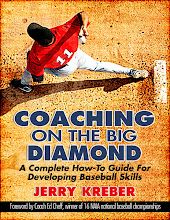Tuesday, January 10, 2006
The Final Stage


Linear Hitting III: “The Fire”
If the “Stretch” stage is the hardest to teach, then the “Fire” stage is the easiest. Since the hitter’s hands stay back in the “Stretch” position, their lead arm should be almost fully extended. The “Fire” stage begins when the hitter’s front leg, which should carry the hitter’s weight, becomes extended. The hitter should aggressively push down on the lead leg and snap it closed. The snapping of the lead leg generates weight transfer through the baseball.
While this movement occurs, the hitter’s back leg, which is weightless, is picked up off the ground. Many times, a hitter’s back foot may be completely lifted off the ground. Frank Thomas, a linear hitter, is a prime example. He generates so much straight-line force that upon rotation his back foot is jerked off the ground. Most hitters complete their swing in what is know as a “Kick Stand” finish. Translated, this simply means that hitters have only their back toe in contact with the ground. If a hitter finishes in this position, it is assured that they have used all their available weight.
With the lead leg extending first, the hitter’s hands are the last body part to fire. As the lead leg straightens, the other body parts turn towards the ball. The hitter should maintain lead arm extension and focus on their hands not drifting during the extension of the lead leg. When the lead arm fires toward the ball, the hitter’s hands should stay relaxed and follow. With a bat that lags around the head area, the hitter should generate excellent bat speed. Dr. Yeager really pounds this point home about lead arm extension and it is very insightful. He states the further back a hitter’s hands start the more force they can apply to the bat while swinging. This is a fact cannot be disputed because it can be proven through measurement.
After contact with the baseball has been made, the hitter will release their top hand before wrist rollover. By releasing the top hand from the bat, the hitter’s bottom hand will continue on a straight-line path. Also, by practicing a top hand release, hitters are trying to create backspin on the pitched ball. By creating backspin, hitters gain distance and velocity due to the Magnus Force principle. If the hitter does not release the top hand, usually topspin is created. Thus, the ball is slow and its distance reduced. Furthermore, hitters must try and finish as high as possible with their hands. When this occurs, it certainly illustrates the hitter gaining maximum extension.
Above, I have posted two hitters finishing the “Fire” phase of the swing. If you break it down to the simplest form, the oral cue would be to “Snap and Fire”. This tells the hitter to snap the lead leg and fire the hands. Each of the pictures, displayed above, illustrates these cues. Each hitter extends the front leg, gains lead arm extension, and practices a top-hand release. All of these hitters, practicing good linear mechanics, use momentum to create a smooth, flowing swing that produces amazing results.
